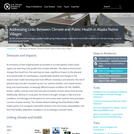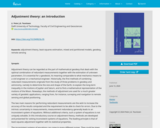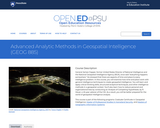
Adding a tail. Created by Karl Wendt.
- Subject:
- Applied Science
- Engineering
- Material Type:
- Lesson
- Provider:
- Khan Academy
- Provider Set:
- Khan Academy
- Author:
- Karl Wendt
- Date Added:
- 02/18/2013

Adding a tail. Created by Karl Wendt.

Summary of how to add a resource to a group.

An overview of Adding an event listener

Learn how to add event listeners in jQuery so that your JavaScript can respond to events on the page, like when a user clicks a button or drags an image.

Adding folder resource to moodle course page. This is a step by step guide to add a folder resource to the Moodle course Page.

An annotated list of resources of different types to support Spanish-language speakers in learning more about Creative Commons.

An introduction to probability through the example of flipping a quarter and rolling a die. it is a practice lesson.

As emissions of heat-trapping bases accumulate in our atmosphere, Earth's polar regions are warming more quickly than at lower latitudes. The rapid environmental changes that result from this warming can have a significant impact on the physical and mental health of rural Alaskans: unpredictable weather and changes in the seasons have made harvesting food more difficult, hazardous, and stressful. The risk of physical injury has also increased, as poor ice, extreme weather, and coastal erosion bring new travel hazards. Increasingly difficult harvest conditions for fish, shellfish, berries, caribou, and sea mammals have also increased concerns about food security. Additionally, declines in snow pack, the threat of drought, changes in lake and river conditions, and damage and disruptions to community water systems have prompted concerns of water security. The climate-related challenge faced by Alaskas tribal health system is to recognize new health stressors and community vulnerabilities, and then find healthy adaptation strategies in an increasingly uncertain future.

Add your particular expertise to the wider community

Adjustment theory can be regarded as the part of mathematical geodesy that deals with the optimal combination of redundant measurements together with the estimation of unknown parameters. It is essential for a geodesist, its meaning comparable to what mechanics means to a civil engineer or a mechanical engineer. Historically, the first methods of combining redundant measurements originate from the study of three problems in geodesy and astronomy, namely to determine the size and shape of the Earth, to explain the long-term inequality in the motions of Jupiter and Saturn, and to find a mathematical representation of the motions of the Moon. Nowadays, the methods of adjustment are used for a much greater variety of geodetic applications, ranging from, for instance, surveying and navigation to remote sensing and global positioning.
The two main reasons for performing redundant measurements are the wish to increase the accuracy of the results computed and the requirement to be able to check for errors. Due to the intrinsic uncertainty in measurements, measurement redundancy generally leads to an inconsistent system of equations. Without additional criteria, such a system of equations is not uniquely solvable. In this introductory course on adjustment theory, methods are developed and presented for solving inconsistent systems of equations. The leading principle is that of least-squares adjustment together with its statistical properties.
The inconsistent systems of equations can come in many different guises. They could be given in parametric form, in implicit form, or as a combination of these two forms. In each case the same principle of least-squares applies. The algorithmic realizations of the solution will differ however. Depending on the application at hand, one could also wish to choose between obtaining the solution in one single step or in a step-wise manner. This leads to the need of formulating the system of equations in partitioned form. Different partitions exist, measurement partitioning, parameter partitioning, or a partitioning of both measurements and parameters. The choice of partitioning also affects the algorithmic realization of the solution. In this introductory text the methodology of adjustment is emphasized, although various samples are given to illustrate the theory. The methods discussed form the basis for solving different adjustment problems in geodesy.

Spreadsheets across the Curriculum Module. Students build a spreadsheet to calculate proper medicine dosages using the metric system.

Indigenous peoples were able to gather their most basic needs for shelter using the items around them. Before lumber became the go to, adobe was a staple building material for the southwest and other Indigenous communities. But what makes this humble brick so simple yet sturdy and sustainable?

Hear about how respect for Earth can help us attain a more sustainable lifestyle in the face of climate change in this video segment adapted from United Tribes Technical College.

This book provides a summary of adult immunizations with guidelines, indications, and contraindications. It was developed for Internal Medicine residents at The Ohio State University Wexner Medicine Center. The book is meant to be a simple read with high yield points to serve as a reference in the primary care clinic setting.

This is a graduate course on the design and analysis of algorithms, covering several advanced topics not studied in typical introductory courses on algorithms. It is especially designed for doctoral students interested in theoretical computer science.

This course is a first-year graduate course in algorithms. Emphasis is placed on fundamental algorithms and advanced methods of algorithmic design, analysis, and implementation. Techniques to be covered include amortization, randomization, fingerprinting, word-level parallelism, bit scaling, dynamic programming, network flow, linear programming, fixed-parameter algorithms, and approximation algorithms. Domains include string algorithms, network optimization, parallel algorithms, computational geometry, online algorithms, external memory, cache, and streaming algorithms, and data structures.

General James Clapper, former United States Director of National Intelligence and the National Geospatial-Intelligence Agency (NGA), once said \everything happens somewhere.\" He stressed that there are aspects of time and place to every intelligence problem. In this course, you will examine how time and place work with general intelligence techniques to create geospatial intelligence. You will learn and apply critical thinking skills, structured analytical techniques, and other intelligence methods in a geospatial context. You'll also learn how to reduce personal and organizational bias by conducting an Analysis of Competing Hypotheses, by R. Heuer, a 45-year veteran of the CIA. As a result, you will be better prepared for the world of geospatial intelligence analysis."

So now that we’ve built and programmed our very own CPU, we’re going to take a step back and look at how CPU speeds have rapidly increased from just a few cycles per second to gigahertz! Some of that improvement, of course, has come from faster and more efficient transistors, but a number hardware designs have been implemented to boost performance. And you’ve probably heard or read about a lot of these - they’re the buzz words attached to just about every new CPU release - terms like instruction pipelining, cache, FLOPS, superscalar, branch prediction, multi-core processors, and even super computers! These designs are pretty complicated, but the fundamental concepts behind them are not. So bear with us as we introduce a lot of new terminology including what might just be the best computer science term of all time: the dirty bit. Let us explain.

Following a brief classroom discussion of relevant principles, each student in this course completes the paper design of several advanced circuits such as multiplexers, sample-and-holds, gain-controlled amplifiers, analog multipliers, digital-to-analog or analog-to-digital converters, and power amplifiers. One of each student’s designs is presented to the class, and one may be built and evaluated. Associated laboratory assignments emphasize the use of modern analog building blocks. This course is worth 12 Engineering Design Points.

This graduate-level course focuses on current research topics in computational complexity theory. Topics include: Nondeterministic, alternating, probabilistic, and parallel computation models; Boolean circuits; Complexity classes and complete sets; The polynomial-time hierarchy; Interactive proof systems; Relativization; Definitions of randomness; Pseudo-randomness and derandomizations;Interactive proof systems and probabilistically checkable proofs.